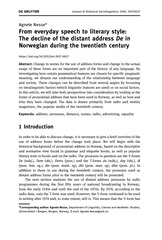| dc.contributor.author | Nesse, Agnete | |
| dc.date.accessioned | 2020-06-16T11:17:12Z | |
| dc.date.available | 2020-06-16T11:17:12Z | |
| dc.date.issued | 2019 | |
| dc.Published | Nesse A. From everyday speech to literary style: The decline of the distant address De in Norwegian during the twentieth century . Journal of Historical Sociolinguistics. 2019;5(1):20170027 | eng |
| dc.identifier.issn | 2199-2908 | |
| dc.identifier.uri | https://hdl.handle.net/1956/22626 | |
| dc.description.abstract | Change in norms for the use of address forms and change in the actual usage of these forms are an important part of the history of any language. By investigating how certain grammatical features are chosen for specific pragmatic meaning, we deepen our understanding of the relationship between language and society. These changes can be described from several angles by focussing on intralinguistic factors (which linguistic features are used) or on social factors. In this article, we will take both perspectives into consideration by looking at the forms of pronominal address that have been used in Norway, as well as how and why they have changed. The data is drawn primarily from radio and weekly magazines, the popular media of the twentieth century. | en_US |
| dc.language.iso | eng | eng |
| dc.publisher | De Gruyter | eng |
| dc.title | From everyday speech to literary style: The decline of the distant address De in Norwegian during the twentieth century | eng |
| dc.type | Peer reviewed | |
| dc.type | Journal article | |
| dc.date.updated | 2019-11-21T14:26:53Z | |
| dc.description.version | publishedVersion | |
| dc.rights.holder | Copyright 2019 Walter de Gruyter GmbH, Berlin/Boston | eng |
| dc.identifier.doi | https://doi.org/10.1515/jhsl-2017-0027 | |
| dc.identifier.cristin | 1693291 | |
| dc.source.journal | Journal of Historical Sociolinguistics | |
